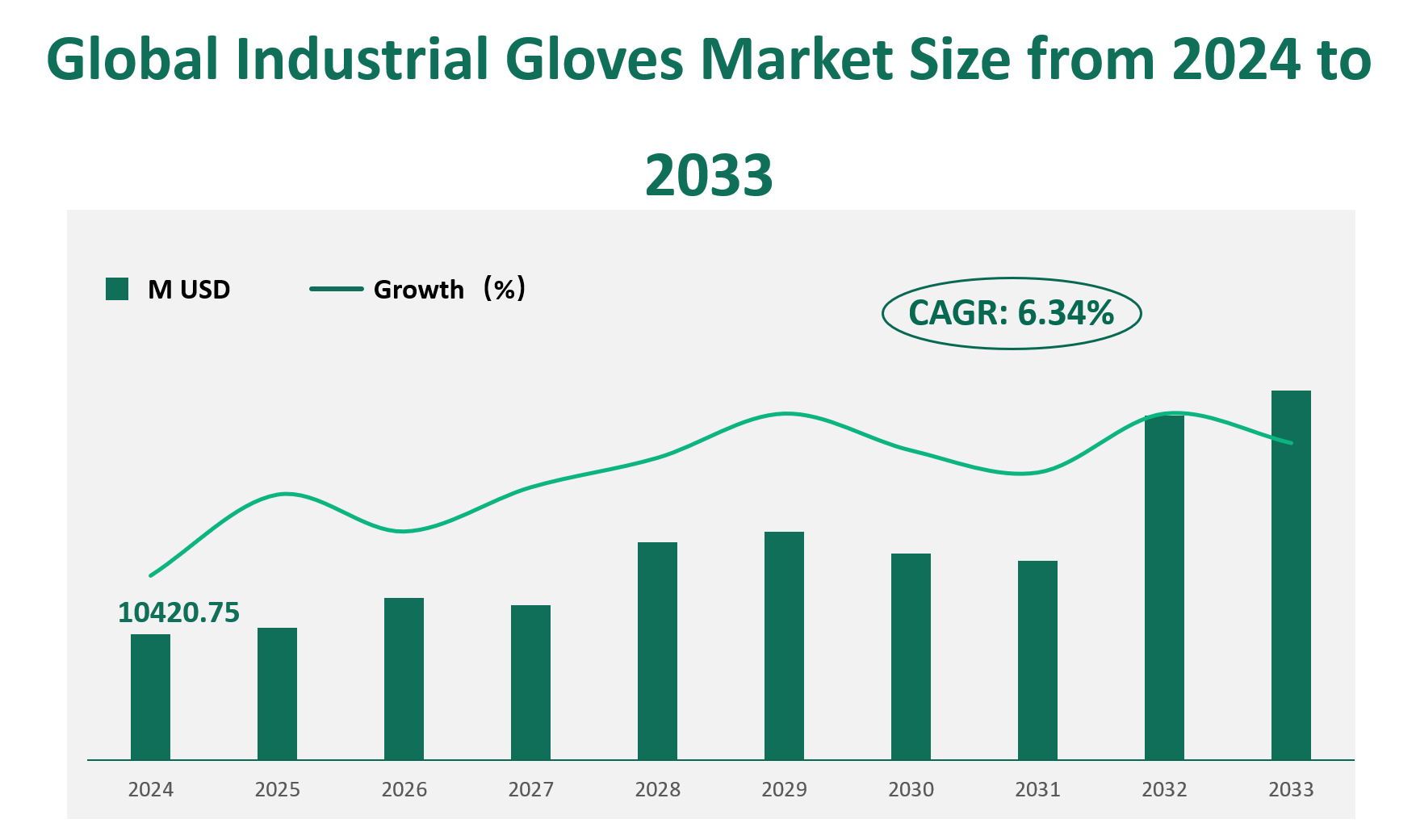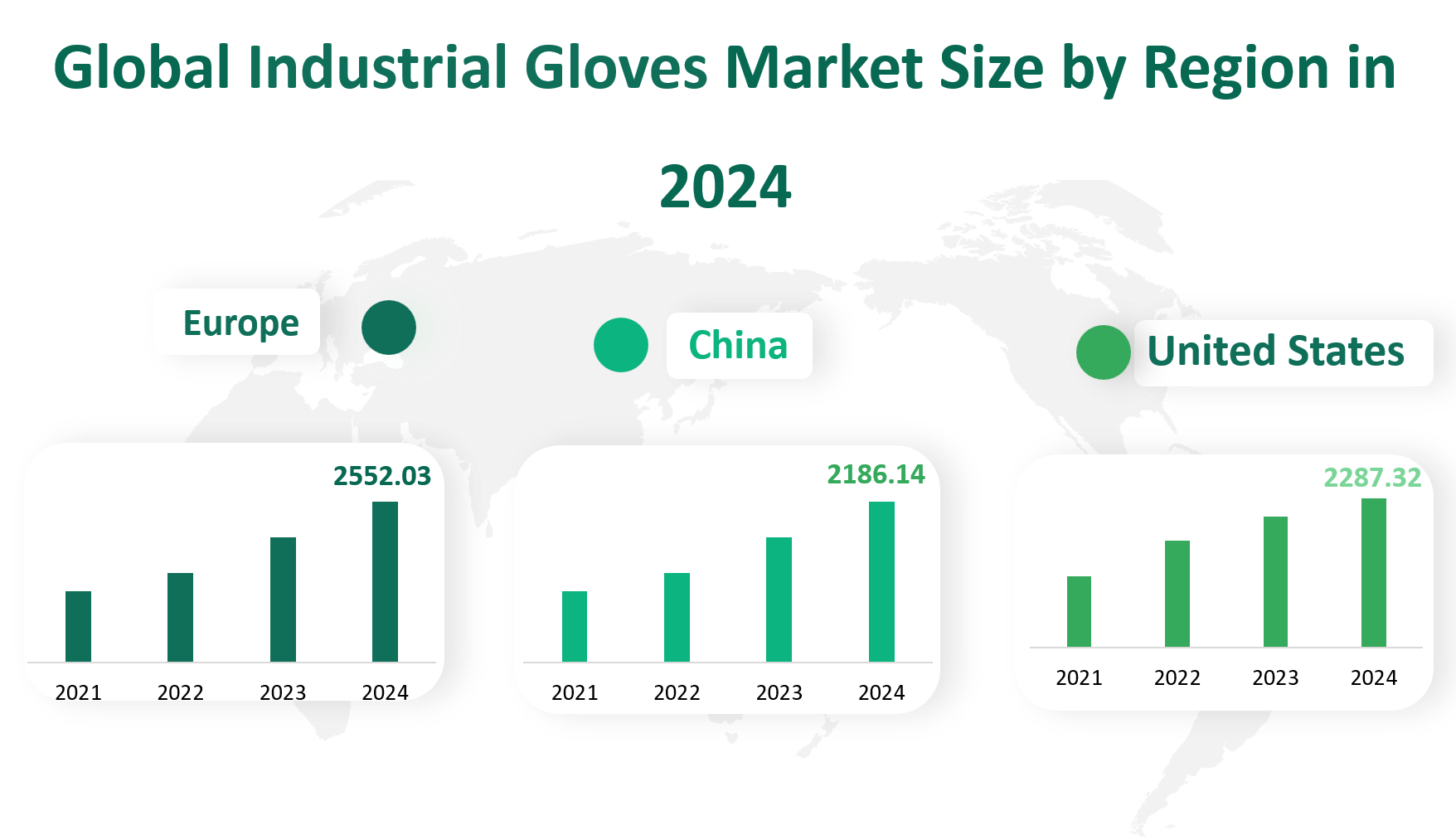1. Global Industrial Gloves Market Revenue and Future Growth
The global industrial gloves market is a significant sector within the broader personal protective equipment (PPE) industry. In 2024, the market is projected to generate a revenue of approximately $10,420.75 million, with a Compound Annual Growth Rate (CAGR) of 6.34% from 2024 to 2033.
Industrial gloves are essential protective gear designed to safeguard workers’ hands from a range of hazards. They are categorized into various types, such as latex, nitrile, and other materials like neoprene and vinyl. These gloves offer protection against chemicals, cuts, punctures, and other physical and environmental hazards. The gloves are widely used in industries where manual dexterity and tactile sensitivity are crucial, such as in manufacturing, assembly lines, and laboratories. The increasing complexity of industrial processes and the need for compliance with stringent safety regulations have further amplified the demand for high-quality industrial gloves.
Figure Global Industrial Gloves Market Size (M USD) and CAGR (2024-2033)

2. Industrial Gloves Market Growth Drivers and Restraints
The growth of the industrial gloves market is influenced by several key driving factors. One of the primary drivers is the rising global demand for workplace safety. As industries evolve and become more complex, the need for effective personal protective equipment has increased. Governments and regulatory bodies worldwide have implemented strict safety regulations, mandating the use of protective gear in hazardous work environments. This has led to a surge in demand for industrial gloves, as companies strive to ensure the safety and well-being of their employees.
Another significant driving factor is the expanding industrial sector. The growth of industries such as automotive, electronics, and pharmaceuticals has created a substantial demand for industrial gloves. These sectors require specialized gloves that provide protection against specific hazards, such as chemical exposure or mechanical injuries. Additionally, the increasing awareness among workers about the importance of personal safety has also contributed to the market’s growth. Workers are more likely to use gloves if they are aware of the potential risks associated with their jobs.
However, the market also faces some limiting factors that could hinder its growth. One of the main challenges is the fluctuation in raw material prices. The primary materials used in the production of industrial gloves, such as natural rubber and synthetic rubber, are subject to price volatility due to factors like supply and demand dynamics, geopolitical issues, and natural disasters. This can impact the profitability of manufacturers and lead to price increases for end consumers.
Another limiting factor is the availability of inexpensive local alternatives in some regions. In developing countries, there is often a preference for low-cost gloves, which may not meet the same quality and safety standards as those produced by established manufacturers. This can affect the market share of premium industrial glove manufacturers and limit their growth potential in these markets. Furthermore, the increasing adoption of automation and robotics in industries may reduce the need for manual labor, thereby affecting the demand for industrial gloves.
3. Technological Innovation in the Industrial Gloves Market
Technological innovation plays a crucial role in the industrial gloves market, as it drives the development of more advanced and effective products. Manufacturers are continuously investing in research and development to improve the performance and functionality of industrial gloves. For instance, advancements in materials science have led to the creation of gloves with enhanced resistance to chemicals, punctures, and abrasions. These innovations not only improve the safety of workers but also enhance the comfort and dexterity of the gloves, making them more appealing to users.
In addition to material advancements, there have been significant developments in manufacturing processes. New technologies, such as automation and robotics, have been integrated into the production lines, increasing efficiency and reducing costs. This has enabled manufacturers to produce gloves at a faster rate and with higher quality standards. Furthermore, innovations in glove design, such as ergonomic shapes and improved grip technologies, have made the gloves more user-friendly and effective in various applications.
4. Analyzing the Different Product Types of Industrial Gloves Market
Industrial gloves are essential protective equipment used across various industries to safeguard workers from hazards. They are categorized into different types based on their material and intended use. The primary types include latex gloves, nitrile gloves, and other.
Latex gloves are made from natural rubber and are known for their excellent elasticity, sensitivity, and fit. They provide a high level of dexterity and tactile sensitivity, making them ideal for tasks requiring precision. These gloves are commonly used in the healthcare sector, food service, and general cleaning applications.
In 2024, the market revenue for latex gloves is projected to be $3328.1 million. The growth of the latex glove market is driven by their widespread use in the healthcare industry, where they are essential for medical procedures and examinations.
Nitrile gloves are made from synthetic rubber and offer superior chemical resistance compared to latex gloves. They are puncture-resistant and provide excellent protection against oils, acids, and other chemicals. Nitrile gloves are widely used in industries such as automotive, chemical manufacturing, and electronics, where resistance to chemicals and durability are crucial.
In 2024, the market revenue for nitrile gloves is expected to reach $4883.7 million. The fastest-growing segment in the industrial glove market, nitrile gloves are gaining popularity due to their allergy-free nature and robust performance. The growth rate of nitrile gloves is attributed to their increasing use in various industries, including healthcare, where they serve as a reliable alternative to latex gloves.
In terms of market share, nitrile gloves hold the largest portion of the industrial glove market, with a projected share of 46.87% in 2024.
Table Global Industrial Gloves Market Size and Share by Type in 2024
Type | Market Size (M USD) 2024 | Market Share |
Latex Gloves | 3328.10 | 31.94% |
Nitrile Gloves | 4883.72 | 46.87% |
Others | 2208.93 | 21.20% |
5. Analyzing the Different Applications of the Industrial Gloves Market
Industrial gloves are used in various applications to provide protection and safety to workers. The primary applications include automotive and transportation, pharmaceuticals, chemicals, food and beverages, and other.
In the automotive and transportation sector, industrial gloves are used for tasks such as assembly, maintenance, and repair. These gloves need to provide protection against chemicals, cuts, and abrasions while maintaining dexterity. In 2024, the market revenue for industrial gloves in this application is projected to be $3116.8 million.
The pharmaceutical industry requires gloves with high levels of chemical resistance and sterility to prevent contamination during drug manufacturing and research. Gloves used in this sector must meet stringent regulatory standards. In 2024, the market revenue for industrial gloves in pharmaceutical applications is expected to reach $873.4 million.
In the chemical industry, gloves must provide robust protection against a wide range of chemicals, including acids, solvents, and corrosive substances. Workers in this sector require gloves that offer high chemical resistance and durability. In 2024, the market revenue for industrial gloves in chemical applications is projected to be $2663.7 million.
In the food and beverage industry, gloves are used to maintain hygiene and prevent contamination during food processing, handling, and preparation. Gloves must be food-safe and provide a barrier against bacteria and other contaminants. In 2024, the market revenue for industrial gloves in this application is expected to reach $2089.0 million.
In terms of market share, the automotive and transportation application holds the largest portion of the industrial glove market, with a projected share of 29.91% in 2024. This dominance is attributed to the extensive use of gloves in various aspects of automotive manufacturing and transportation-related activities. The chemical industry follows with a market share of 25.56%, driven by the need for high chemical resistance in glove applications. The food and beverages application accounts for 20.05% of the market, reflecting the growing emphasis on food safety and hygiene.
Table Global Industrial Gloves Market Size and Share by Application in 2024
Application | Market Size (M USD) 2024 | Market Share |
Automotive & Transportation | 3116.82 | 29.91% |
Pharmaceuticals | 873.43 | 8.38% |
Chemicals | 2663.76 | 25.56% |
Food & Beverages | 2089.06 | 20.05% |
Others | 1677.68 | 16.10% |
6. Global Industrial Gloves Market Size by Region
United States market revenue in 2024 is approximately $2287.32 million. The demand for industrial gloves in United States is driven by stringent safety regulations and a high level of industrial activity. Additionally, the healthcare industry in USA is highly developed, contributing to the demand for gloves in medical procedures and examinations.
Europe is another major player in the industrial gloves market, with a revenue of $2552.03 million in 2024. The European market is characterized by a strong emphasis on worker safety and compliance with international standards. The region also benefits from a high level of technological advancement, which influences the demand for high-quality industrial gloves.
China, with a revenue of $2186.14 million in 2024, is a rapidly growing market for industrial gloves. China has extensive manufacturing capabilities and large workforce.
Latin America’s revenue from industrial gloves in 2024 is $345.71 million. The Middle East and Africa region generated a revenue of $403.65 million in 2024.
Figure Global Industrial Gloves Market Size by Region in 2024

7. Global Industrial Gloves Market Analysis by Major Players
7.1 Top Glove Corporation Bhd
Company Introduction and Business Overview:
Top Glove Corporation Bhd is a leading global manufacturer of gloves, headquartered in Malaysia. Established in 1991, the company has expanded its operations to include manufacturing facilities in Malaysia, Thailand, and China. Top Glove focuses on producing high-quality gloves for various applications, including medical, industrial, and consumer use. The company’s commitment to innovation and excellence has enabled it to become a dominant player in the industrial gloves market.
Products Offered:
Top Glove offers a wide range of industrial gloves, including nitrile, latex, and vinyl gloves. Their products are designed to provide superior protection, comfort, and durability. The company’s gloves are used in industries such as automotive, electronics, and manufacturing, where protection against chemicals, cuts, and abrasions is crucial.
Sales Revenue in 2022:
In 2022, Top Glove Corporation Bhd generated a revenue of $662.28 million.
7.2 Honeywell International, Inc.
Company Introduction and Business Overview:
Honeywell International Inc. is a multinational conglomerate corporation headquartered in Charlotte, North Carolina, USA. Established in 1885, the company operates in various business areas, including aerospace, building technologies, performance materials and technologies, and safety and productivity solutions. Honeywell’s industrial gloves division focuses on providing high-quality protective gloves for various industries.
Products Offered:
Honeywell offers a diverse range of industrial gloves, including chemical-resistant gloves, cut-resistant gloves, and gloves designed for specific applications such as welding and electrical work. Their gloves are made from materials like nitrile, latex, and neoprene, ensuring durability and protection against various hazards.
Sales Revenue in 2022:
In 2022, Honeywell International, Inc. generated a revenue of $698.19 million from its industrial gloves business.
7.3 Hartalega Holdings Berhad
Company Introduction and Business Overview:
Hartalega Holdings Berhad is a leading manufacturer of nitrile gloves, headquartered in Malaysia. Established in 1988, the company has grown to become one of the largest producers of nitrile gloves globally. Hartalega focuses on providing high-quality gloves for medical and industrial applications, emphasizing innovation and sustainability in its operations.
Products Offered:
Hartalega offers a variety of nitrile gloves, including medical examination gloves, surgical gloves, and industrial gloves. Their gloves are designed to provide excellent protection against chemicals, punctures, and abrasions. The company also offers gloves with unique features such as polymer coating for enhanced comfort and performance.
Sales Revenue in 2022:
In 2022, Hartalega Holdings Berhad generated a revenue of $695.45 million.

